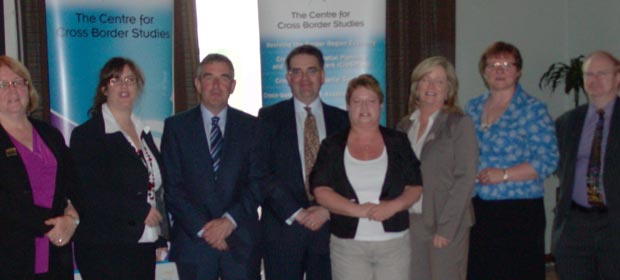A number of service areas where there is existing work – or potential for future work – in cross-border service delivery, have been identified by a new cross border acute services modelling tool, which is being used to establish how cross border hospital services can provide mutual benefits for the people of the border region, writes Vanya Sargent.
A number of service areas where there is existing work – or potential for future work – in cross-border service delivery, have been identified by a new cross border acute services modelling tool, which is being used to establish how cross border hospital services can provide mutual benefits for the people of the border region.

The clinical areas being examined as exemplar services as part of the report are orthopaedic surgery; otolaryngology (ENT); paediatric cardiac surgery; cystic fibrosis; and acute mental health. Some of these clinical areas, such as orthopaedic surgery and ENT, relate to the provision of services to people in the border region, while paediatric cardiac surgery, for example, is a tertiary service that ideally should be considered on a national or indeed all-island basis. The final report will also contain some considerations in respect of Accident and Emergency Departments within the border regions.
There is relatively little cross-border planning at the strategic level, i.e. between the two Departments, or between the HSC Board and the HSE, in any structured, formal or high-profile fashion
The development of the cross-border acute services modelling tool is being conducted by Howth Bastow Charleton for the Centre for Cross Border Studies. http://www.crossborder.ie.
The key focus of the project is to support strategic cross-border co-operation for a more prosperous and sustainable region by exploring the potential for cross-border hospital services in the Irish border region. The development of a prototype modelling tool is designed to be a methodological process to assist in the decision-making process in assessing the potential for particular services to be designed on a cross-border or all-island basis. It is aimed at those who are involved in acute healthcare service planning or delivery, both in the border regions and on a regional or national basis. http://www.crossborder.ie/research/cross-border-hospital-services/
There are clear areas of need in NI and RoI, where waiting lists are problematic and growing, and where the capacity of any one organisation or hospital to engage sufficient resources is constrained
We presented a range of emerging findings at the Emerging Findings Conference on May 12, 2011 in Dundalk, including the following, which provide a flavour of the research arising from the project to date:
- There is relatively little cross-border planning at the strategic level, i.e. between the two Departments, or between the HSC Board and the HSE, in any structured, formal or high-profile fashion. However, CAWT (Co-operation and Working Together www.cawt.com, a cross border health and social care partnership comprising the Health and Social Care Board and the Public Health Agency in Northern Ireland, the border counties of the HSE in the Republic of Ireland and the Southern and Western HSC Trusts in Northern Ireland) is managing a range of cross border health and social care programmes, part financed by the EU INTERREG IVA cross-border Programme.
- Projects successfully developed over the last few years by CAWT have shown demonstrably that many of the suggested obstacles to cross-border care – ranging from professional registration and indemnity through to clinical standards and funding – can and have been overcome.
- There are clear areas of need in NI and RoI, where waiting lists are problematic and growing, and where the capacity of any one organisation or hospital to engage sufficient resources is constrained. Orthopaedic surgery is one clear example, probably the most significant, of these.
- Much of the problem relating to demand exceeding supply appears to relate to the North-West region. It might be a consideration that one critical issue here is rurality.
- There are separate issues for tertiary services which arguably should only be provided in one location on the island of Ireland. This issue is restricted to only a tiny handful of services (including paediatric cardiac surgery, which is an area of specific focus for our research).
- The real issue is the development of managed clinical networks where resources, expertise, facilities, staff, etc. are shared between service providers across boundaries.
The prototype modelling tool under development, which was discussed in more detail at the conference, represents a modelling methodology – to aid decision-making rather than to provide easy answers – for planning cross-border services, comprising the following key “building blocks”:
- Decision tree: A decision tree is a tool to assess the suitability of a project by asking key questions and making decisions on whether to progress on the basis of the answers.
- Needs analysis: An assessment of the demand for a particular service within a particular catchment area, including for example current activity, waiting lists, and epidemiology.
- Supply factors: The capacity of the health services to provide the service, including where the service is provided, restrictions such as critical mass and safety considerations, and clinical requirements.
- Access: This considers whether services require to be accessible to patients within time or distance constraints and the willingness of patients to travel for treatment.
- Service: Issues such as the quality of service delivered, the outcomes, and the patient experience all need to be taken into account.
The development of the prototype modelling tool will be accompanied by a comprehensive report examining the issues surrounding the debate on cross-border healthcare and their impact on the use of the tool to develop opportunities for future cross-border and all-island service development. The report and the tool will contribute to the understanding of why and how cross-border healthcare can and should be developed into the future.
Vanya Sargent, Horwath Bastow Charleton for the Centre for Cross-Border Studies

